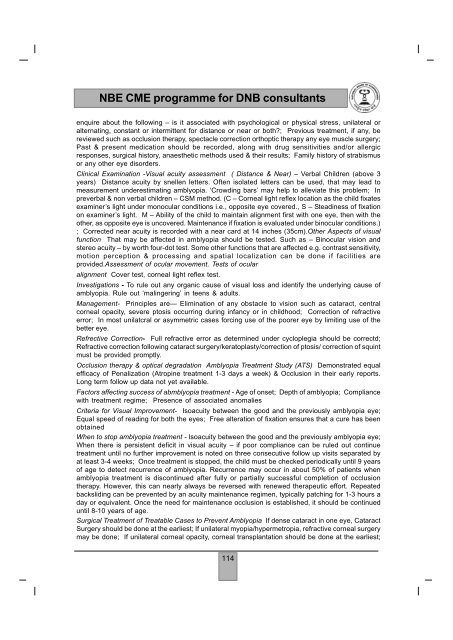NBE CME programme for DNB consultants - National Board Of ...
NBE CME programme for DNB consultants - National Board Of ...
NBE CME programme for DNB consultants - National Board Of ...
You also want an ePaper? Increase the reach of your titles
YUMPU automatically turns print PDFs into web optimized ePapers that Google loves.
<strong>NBE</strong> <strong>CME</strong> <strong>programme</strong> <strong>for</strong> <strong>DNB</strong> <strong>consultants</strong>enquire about the following – is it associated with psychological or physical stress, unilateral oralternating, constant or intermittent <strong>for</strong> distance or near or both?; Previous treatment, if any, bereviewed such as occlusion therapy, spectacle correction orthoptic therapy any eye muscle surgery;Past & present medication should be recorded, along with drug sensitivities and/or allergicresponses, surgical history, anaesthetic methods used & their results; Family history of strabismusor any other eye disorders.Clinical Examination -Visual acuity assessment ( Distance & Near) – Verbal Children (above 3years) Distance acuity by snellen letters. <strong>Of</strong>ten isolated letters can be used, that may lead tomeasurement underestimating amblyopia. ‘Crowding bars’ may help to alleviate this problem; Inpreverbal & non verbal children – CSM method. (C – Corneal light reflex location as the child fixatesexaminer’s light under monocular conditions i.e., opposite eye covered., S – Steadiness of fixationon examiner’s light. M – Ability of the child to maintain alignment first with one eye, then with theother, as opposite eye is uncovered. Maintenance if fixation is evaluated under binocular conditions.); Corrected near acuity is recorded with a near card at 14 inches (35cm).Other Aspects of visualfunction That may be affected in amblyopia should be tested. Such as – Binocular vision andstereo acuity – by worth four-dot test. Some other functions that are affected e.g. contrast sensitivity,motion perception & processing and spatial localization can be done if facilities areprovided.Assessment of ocular movement. Tests of ocularalignment Cover test, corneal light reflex test.Investigations - To rule out any organic cause of visual loss and identify the underlying cause ofamblyopia. Rule out ‘malingering’ in teens & adults.Management- Principles are— Elimination of any obstacle to vision such as cataract, centralcorneal opacity, severe ptosis occurring during infancy or in childhood; Correction of refractiveerror; In most unilatcral or asymmetric cases <strong>for</strong>cing use of the poorer eye by limiting use of thebetter eye.Refrective Correction- Full refractive error as determined under cycloplegia should be correctd;Refractive correction following cataract surgery/keratoplasty/correction of ptosis/ correction of squintmust be provided promptly.Occlusion therapy & optical degradation Amblyopia Treatment Study (ATS) Demonstrated equalefficacy of Penalization (Atropine treatment 1-3 days a week) & Occlusion in their early reports.Long term follow up data not yet available.Factors affecting success of abmblyopia treatment - Age of onset; Depth of amblyopia; Compliancewith treatment regime; Presence of associated anomaliesCriteria <strong>for</strong> Visual Improvement- Isoacuity between the good and the previously amblyopia eye;Equal speed of reading <strong>for</strong> both the eyes; Free alteration of fixation ensures that a cure has beenobtainedWhen to stop amblyopia treatment - Isoacuity between the good and the previously amblyopia eye;When there is persistent deficit in visual acuity – if poor compliance can be ruled out continuetreatment until no further improvement is noted on three consecutive follow up visits separated byat least 3-4 weeks; Once treatment is stopped, the child must be checked periodically until 9 yearsof age to detect recurrence of amblyopia. Recurrence may occur in about 50% of patients whenamblyopia treatment is discontinued after fully or partially successful completion of occlusiontherapy. However, this can nearly always be reversed with renewed therapeutic ef<strong>for</strong>t. Repeatedbacksliding can be prevented by an acuity maintenance regimen, typically patching <strong>for</strong> 1-3 hours aday or equivalent. Once the need <strong>for</strong> maintenance occlusion is established, it should be continueduntil 8-10 years of age.Surgical Treatment of Treatable Cases to Prevent Amblyopia If dense cataract in one eye, CataractSurgery should be done at the earliest; If unilateral myopia/hypermetropia, refractive corneal surgerymay be done; If unilateral corneal opacity, corneal transplantation should be done at the earliest;114
















